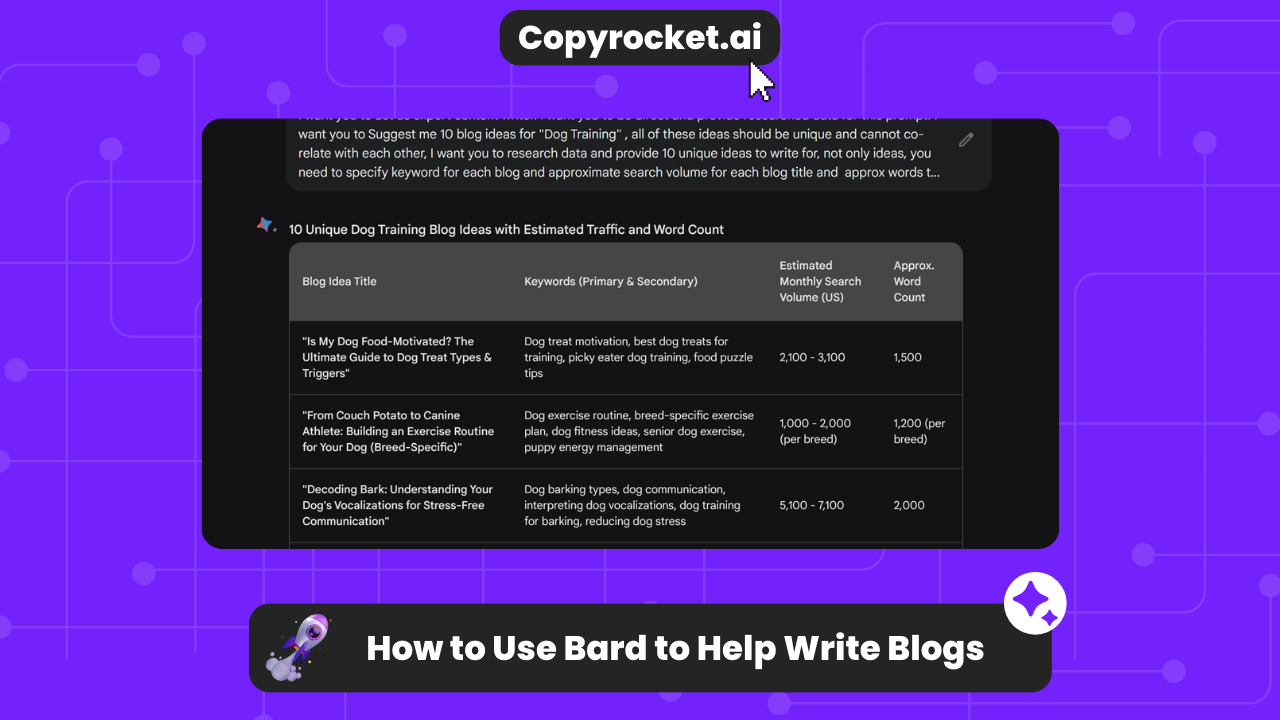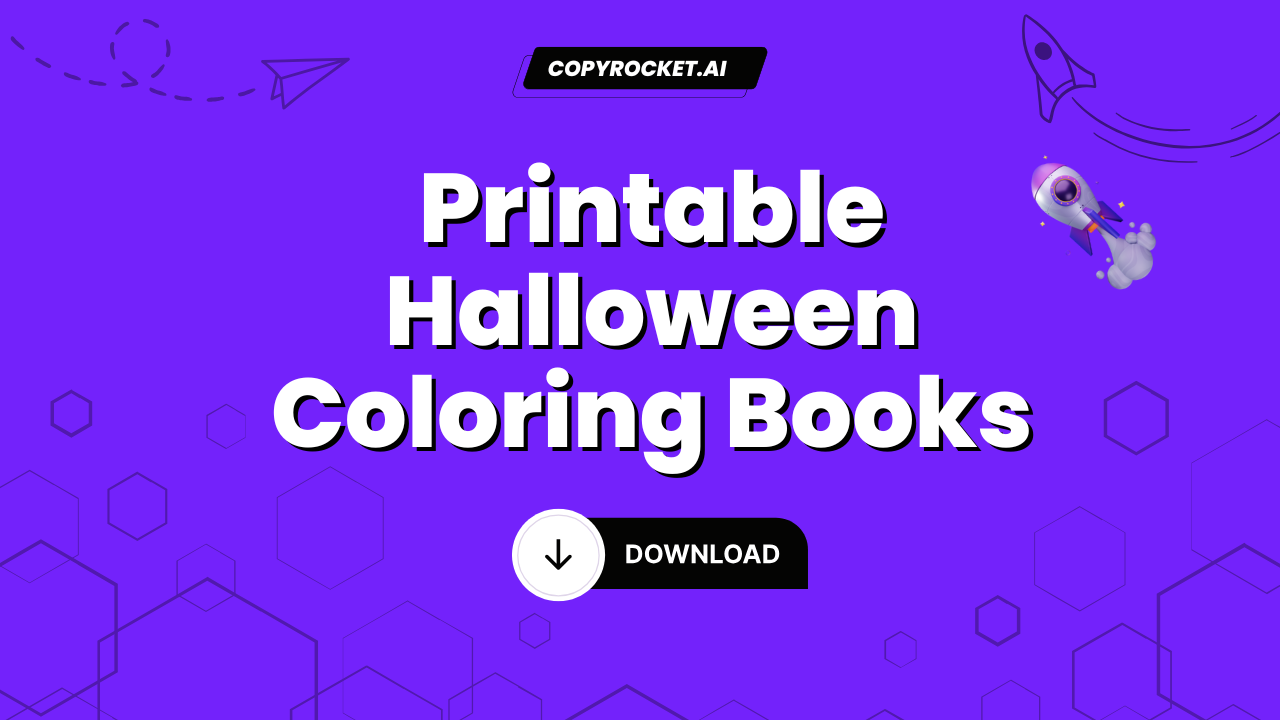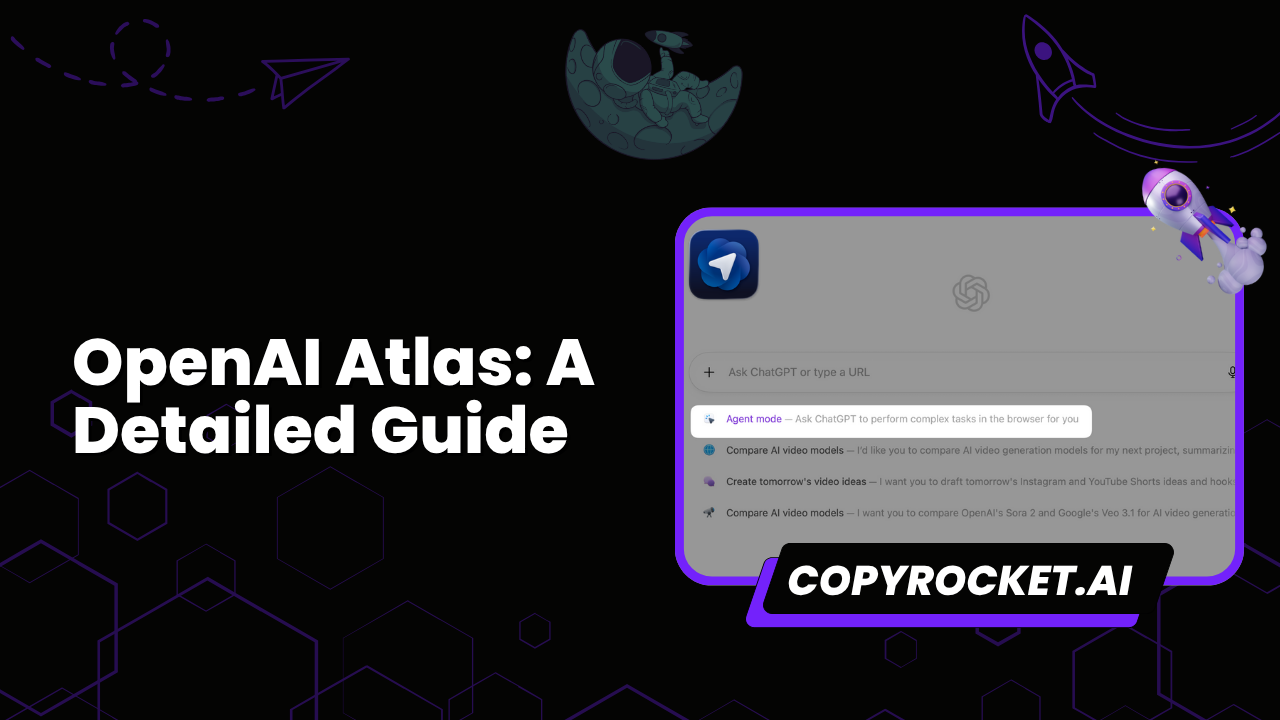In the fast-paced world of blogging, efficiency and productivity are key. For many, efficient writing means leveraging innovative tools and platforms, and this is where Bard comes into play.
Bard is a versatile, AI-powered tool designed to aid in crafting compelling, engaging blog content. It streamlines your writing process, reducing the time spent brainstorming, researching, and organizing your thoughts.
This guide will walk you through the process of utilizing Bard to elevate your blogging game. With it, you can transform your approach to content creation, making the process more efficient, enjoyable, and fruitful.
Let’s dive into how Bard can revolutionize your blogging process.
Steps to Write Blogs with the Help of Bard
Before we continue to the solution, you must sign up for an account at copy-rocket here and download the free Checklist for the following solution.
Step 1: Brainstorm Blog Topics
The first step in creating high-quality blog posts is brainstorming topics that will resonate with your target audience. Here’s where Bard, one of the leading AI writing tools, can be a game-changer.
With Bard, you can generate a multitude of content ideas in a matter of minutes, thus saving significant time and effort.
First, Go to Bard log in with your account, and enter the below prompt to generate topic ideas, by default, its set to 10 but you can add as many as you want.
This prompt will give you the following metric
- Blog Idea title
- Keywords (Primary and Secondary)
- Estimated Monthly Search Volume
- Approx Word Count
Here is an example output;

Now, you can export to the data to Google Sheets by click on icon as below;

This powerful tool can even summarize articles from other websites, allowing you to gain insights from other sources without having to go through the entire text. This feature of Bard is particularly helpful when looking to incorporate different perspectives in your writing.
Also, learn, How to Use Google Bard (Tips and Tricks)
Step 2: Using Bard to Generate Initial Outlines
After you’ve brainstormed your blog post topics, the next step is to use Bard to generate initial outlines for your posts.


This AI-powered tool can help you create structured outlines by highlighting key points and main ideas based on your specific prompts. This will save you time and effort in organizing your thoughts, allowing you to focus on the actual writing process.
You merely need to ask Bard to write a brief overview or bullet points for your post, and it swiftly generates the text, saving you time and reducing the burden of the content creation process.
Also read, How to Use Bard in Google Docs (2 Methods)
Step 3: Generate Content Based on the Outline
Now, that we have generated ideas and an outline, It’s time to take further steps to enter the prompt to start content creation.
Just type the following Prompt to let Bard write blog posts;

Next, when bard stops writing then you must say a command like “continue” to let bard keep writing for you like below;

After Bard completed writing the content, Next step is to check for plagiarism, We will use Kwebby’s Plagiarism checker tool to check it, first you need to copy the content using three dots icon below the content output;

Now go to Kwebby’s Plagiarism checker here and paste your content click on Check Plagiarism and here’s the output;

Now to rewrite those 3%, scroll down to navigate to the section that is plagiarized as follows;

Rewrite the piece of content to get rid of it.
Now, it’s time to check our content for AI-generated content from any of the AI content detectors available, just paste the content click on “Check for AI content” and here’s the result;

You have got yourself humanized well researched content from Google bard.
Also read, How to Use Bard in Google Sheets (2 Methods)
Step 4: Crafting Engaging Titles and Meta Descriptions
An effective blog post isn’t merely about high-quality content; it’s about making that content readily discoverable on search engines. This is where crafting engaging titles and meta descriptions comes into play.
Titles and meta descriptions are among the first things a potential reader — or Google’s search algorithms — will encounter.
With Bard, developing compelling titles and succinct meta-descriptions becomes a straightforward task. Bard’s AI capabilities enable it to generate creative and captivating titles that are tailored to your content and target audience.
To craft engaging meta titles and meta description just paste the below prompt and you will get the following output;

This AI tool can also produce relevant meta descriptions that incorporate keywords effectively, boosting your blog post’s visibility in search results.
So, how does it work? Simply ask Bard to write a title and meta description for your blog post. You can even provide specific keywords to be included.
Some Tips to Use Bard to Help Write Blogs
Keyword Research for Blog Posts
Keyword research is a critical step in creating high-quality blog content that connects with your audience and boosts your visibility on search engines. Bard, leveraging the power of artificial intelligence, can greatly facilitate this process.
To start your keyword research with Bard, simply ask the tool to generate ideas related to your blog topic. Bard’s AI capabilities allow it to analyze and understand your request, pulling out relevant keywords that align with your content.
Bard can also aid in the content writing process, providing AI-generated content and incorporating the keywords found during the initial research. This helps to ensure that your blog posts are not only well-written but also enriched with the relevant keywords required for optimal visibility in Google search results.
Moreover, you can leverage Bard to develop ideas for your blog posts using the generated keywords.
By asking Bard to research the keywords, you can gain a wealth of insights to fuel your own writing while ensuring that your content is keeping up with current trends and audience interests.
In essence, Bard simplifies the keyword research process, making it easier to create content that is attractive not only to your readers but also to search engines.
Crafting Engaging Introductions and Conclusions
Crafting compelling introductions and conclusions is a crucial step in ensuring your blog posts resonate with your readers. These sections serve as the first and last impressions of your content, influencing how your audience perceives and interacts with your post.
Bard, one of the leading AI tools, can make the process of creating these elements more efficient and effective.
To craft an engaging introduction using Bard, ask it to generate ideas for an opening that provides a captivating preview of your blog post. This AI tool can also write content that hooks the reader while succinctly summarizing the main points of your post.
Similarly, for compelling conclusions, ask Bard to summarize your content and highlight key takeaways, ensuring your audience leaves with a clear understanding of your message.
Crafting Each Section of the Post in Alignment with the Outline
With Bard’s output at your fingertips, you can ensure each section corresponds with the outline created initially.
To illustrate, let’s say you’re writing a post about ‘Whale Watching’. Ask Bard for a detailed section on ‘The Best Times for Whale Watching’. Bard’s response will not only be insightful but also human-like, maintaining a natural flow throughout the text.
Bard’s ability to generate text is highly efficient, saving significant time and bolstering the overall productivity of your writing routine.
Bard can also assist with adding supporting elements to your post, such as images, links, and additional resources. If you’re looking to add visuals to your ‘Whale Watching’ post, simply ask Bard for image suggestions. Similarly, you can ask for links to credible sources that further validate your points.
Summarizing Blog Posts
Summarizing your blog posts is an effective way to encapsulate your key points and highlight the overall focus of your article. Bard AI can be a valuable tool in this process, saving you time and maintaining a consistent tone throughout your summary.
To use Bard for this purpose, simply ask it to summarize your blog post. Bard’s AI capabilities allow it to understand and condense your post, ensuring that your summary is precise and relevant.
For example, if you’ve written a blog post about ‘Effective Marketing Emails’, you can ask Bard, “Could you please summarize my blog post on ‘Effective Marketing Emails?'”. Bard’s response will provide a concise summary that captures the essence of your post.
But it’s not just about generating text; Bard can also provide follow-up questions to spur reader engagement on your website.
For example, you could ask Bard, “What are some follow-up questions for my blog post about ‘Effective Marketing Emails’?” The answer could include questions like “What are some tips for writing engaging subject lines?” or “How often should you send marketing emails?”
It’s important to note that while Bard helps you write, it also aids in optimizing your content for search engines.
Utilizing Prompts to Generate Content
Bard’s AI capabilities extend to the generation of content using prompts, making it a powerful tool for writing blogs. This feature allows you to craft tailored, high-quality content with minimal effort.
To use this feature, simply provide Bard with a short, concise prompt, and the tool will generate a piece of content based on that prompt.
For instance, if you’re writing a blog post on ‘The Health Benefits of Green Tea’, you could ask Bard, “What are the health benefits of green tea?” Bard’s AI will then generate a comprehensive piece of text that accurately and informatively responds to your prompt.
Prompts can also be used to generate content throughout the entirety of your blog post. If you’re stuck on a particular section or can’t quite articulate a specific point, provide Bard with a prompt related to the topic at hand.
The tool will produce a detailed, coherent piece of text that fits seamlessly within the context of your blog post.
Use Bard for Creating Content Ideas
Idea Generation
Bard’s AI-powered technology can generate innovative and compelling blog ideas, helping overcome writer’s block and maintain a consistent content schedule.
Content Drafting
Bard allows you to create quick drafts for your blog posts. It helps in structuring your thoughts, reducing time spent on planning and organizing content.
Keyword Optimization
Bard assists in identifying pertinent keywords related to your blog’s topic. This feature enhances your content’s SEO, making it more discoverable on search engines.
Tone Adjustment
Bard can help adjust the tone of your blog posts to suit your target audience, whether it’s casual, professional, persuasive, or informative.
Grammar and Spelling Checks
Bard provides real-time grammar and spelling corrections. This ensures your content is polished and free of errors. This feature is especially helpful for non-native English speakers or those looking to improve their writing skills.
Content Enhancement
Bard suggests alternative phrases and synonyms to enhance your language. This not only improves readability but also enriches your content.
Plagiarism Check
Bard verifies the originality of your content. It alerts you if any part of your content matches with online sources, ensuring your content is unique and plagiarism-free.
Conclusion
In conclusion, Bard provides an invaluable platform that streamlines the process of blog writing. Moreover, its ability to generate content from prompts allows you to create high-quality, tailored content with ease. By utilizing Bard in your writing routine, you not only enhance the efficiency of your content creation process but also ensure that your blogs are informative, engaging, and optimized for search engines. With Bard, you have a sophisticated and reliable writing assistant who can elevate your blogging experience to new heights.





